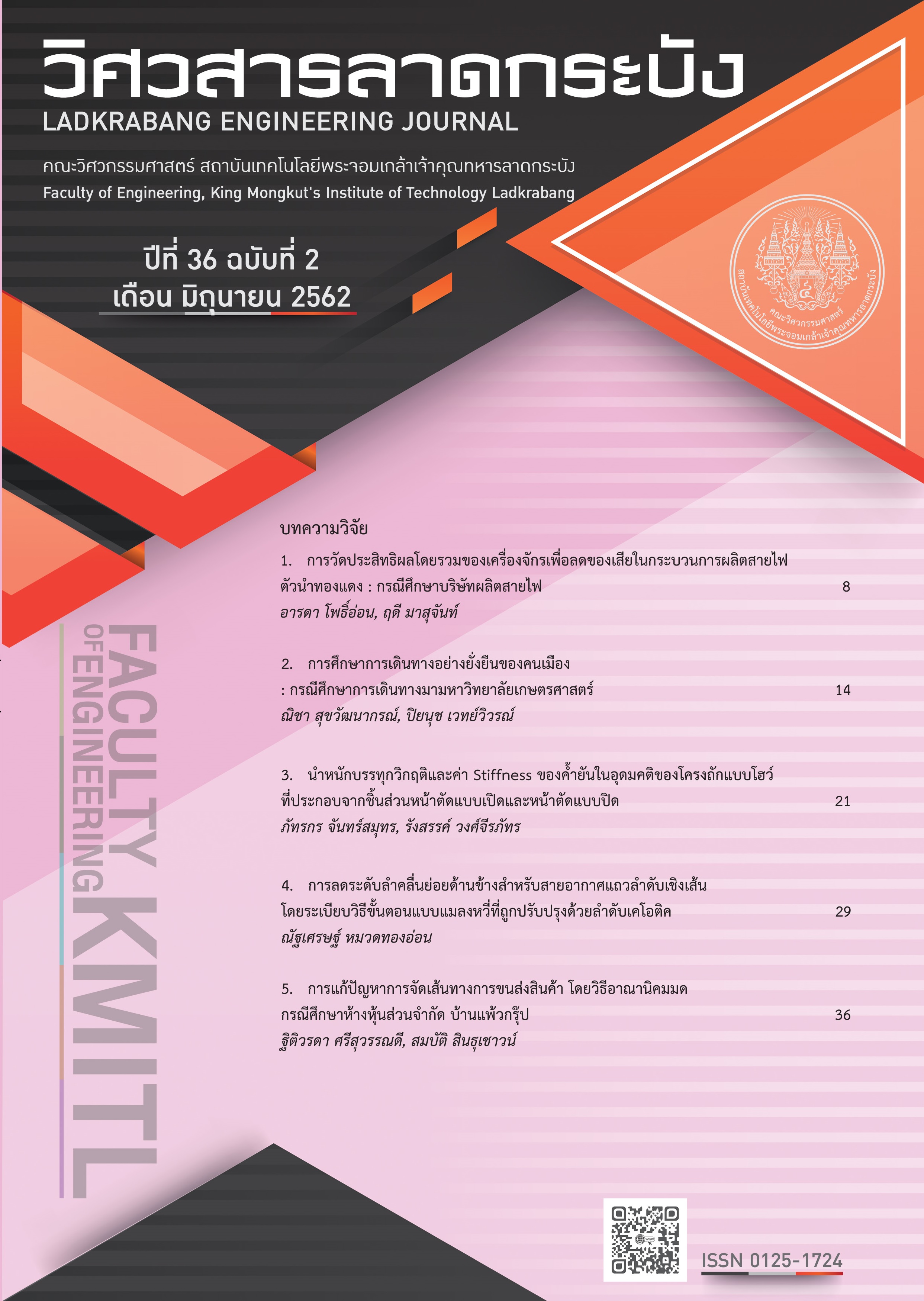Overall Equipment Effectiveness to Reduce Waste in Production Process of Copper Wires : Case Study of Wire Manufacturer
Keywords:
Defect reduction, Overall Equipment Effectiveness, Breakdown maintenance, Autonomous maintenance, Preventive maintenanceAbstract
The objective of this research was to increase the effectiveness of production by reducing defects in the extrusion process. At present, the company case study found problems of quality control. It was found that the most common defect at percentage of extrusion process 9.95, The percentage 88.43 of defects in all the extrusion process, and the Overall Equipment Effectiveness and of the extrusion machine had an average of 54.49 percent from the data of defect and the Overall Equipment Effectiveness of the aforementioned machine was occurred from the discovery of defect in the production process which caused the machine breakdown that caused an average of machine availability was at 64.15 percent, which was lower than the standard. From the above problems, the researcher have improved the efficiency of the production process, and reduced defect by use the theory of the preparing repair the mechanic to apply for production, perform maintenance on your own, perform preventive maintenance, preparing a plan for the maintenance as broken then repaired to, preparing a plan for the maintenance as broken then repaired to reduce the loss time from the maintenance, creating a plan to change the extrusion ring in order, check the extrusion solution every time before turning on the machine, and assigned the supervisor to randomly check every week. After the improvement, it was found that the company case study had defect reduction from 9.95 was reduced to 1.65 percent or the average was reduced to 83.46 percent, the Overall Equipment Effectiveness of the extrusion machine was increased with an average of 81.07 percent, the availability was increased with an average of 90.28 percent and the capability of cost reduction was about 500,000 THB per month.
References
H.Zhang, A.Li, L.Xu and M.Giovanni, “Automatic Estimate of OEE Considering Uncertainty” Procedia CIRP, Vol.81, pp.630-635, 2019.
M.Yukitaka, “Quality control of mass production components based on defect analysis” Metal Fatigue, pp.669-687, 2019.
A.Mazher and M.Khan, “Reliable Preventive Maintenance Scheduling” AIIE Transactions, Vol.11, pp.221-228, 2007.
G.Frank, C.Paul, G.Lizbeth, N.Anthony and H.Vincent, “Improving manufacturing productivity by combining cognitive engineering and lean-six sigma methods” Procedia CIRP, Vol.81, pp.641-646, 2019.
S.Anand and K.N.Nandurkar, “Optimizing & Analysing Overall Equipment Effectiveness (OEE) Through Design of Experiments (DOE)” Procedia Engineering Vol.38, pp.2,973-2,980, 2012.
F.Luca, M.Marco and G.Alice, “Orchestration of preventive maintenance interventions” IFAC-Papers Online Vol. 50, pp.13,976 - 13,981, July, 2017.
P.Guariente, I.Antoniolli, L.Pinto Ferreira, T.Pereira and F.J.G.Silva, “Implementing autonomous maintenance in an automotive components manufacturer” Procedia Manufacturing, Vol.13, pp. 1,128-1,134, 2017.
W.Torgeir and R.Geir “Beyond Waste Elimination: Assessing Lean Practices in Product Development” Procedia CIRP, Vol.50, pp. 179-185, 2016 .
O.Thanee, “Total Productive maintenance”, Peak-blue, Nonthaburi, 2009.
M.Ozkok, “The effects of machine breakdown on hull structure production process” Scientia Iranica, Vol. 20, pp. 900-908, June, 2013.
N.Chantran, “Industrial Maintenance Management Technology”, Charansanitwong-printing, Bangkok, 2016.
S.Ehram and S.Seyed, “A hybrid method for flowshops scheduling with condition-based maintenance constraint and machines breakdown” Expert Systems with Applications, Vol. 38, pp.2,020-2,029, March, 2011.
Downloads
Published
How to Cite
Issue
Section
License
The published articles are copyrighted by the School of Engineering, King Mongkut's Institute of Technology Ladkrabang.
The statements contained in each article in this academic journal are the personal opinions of each author and are not related to King Mongkut's Institute of Technology Ladkrabang and other faculty members in the institute.
Responsibility for all elements of each article belongs to each author; If there are any mistakes, each author is solely responsible for his own articles.






